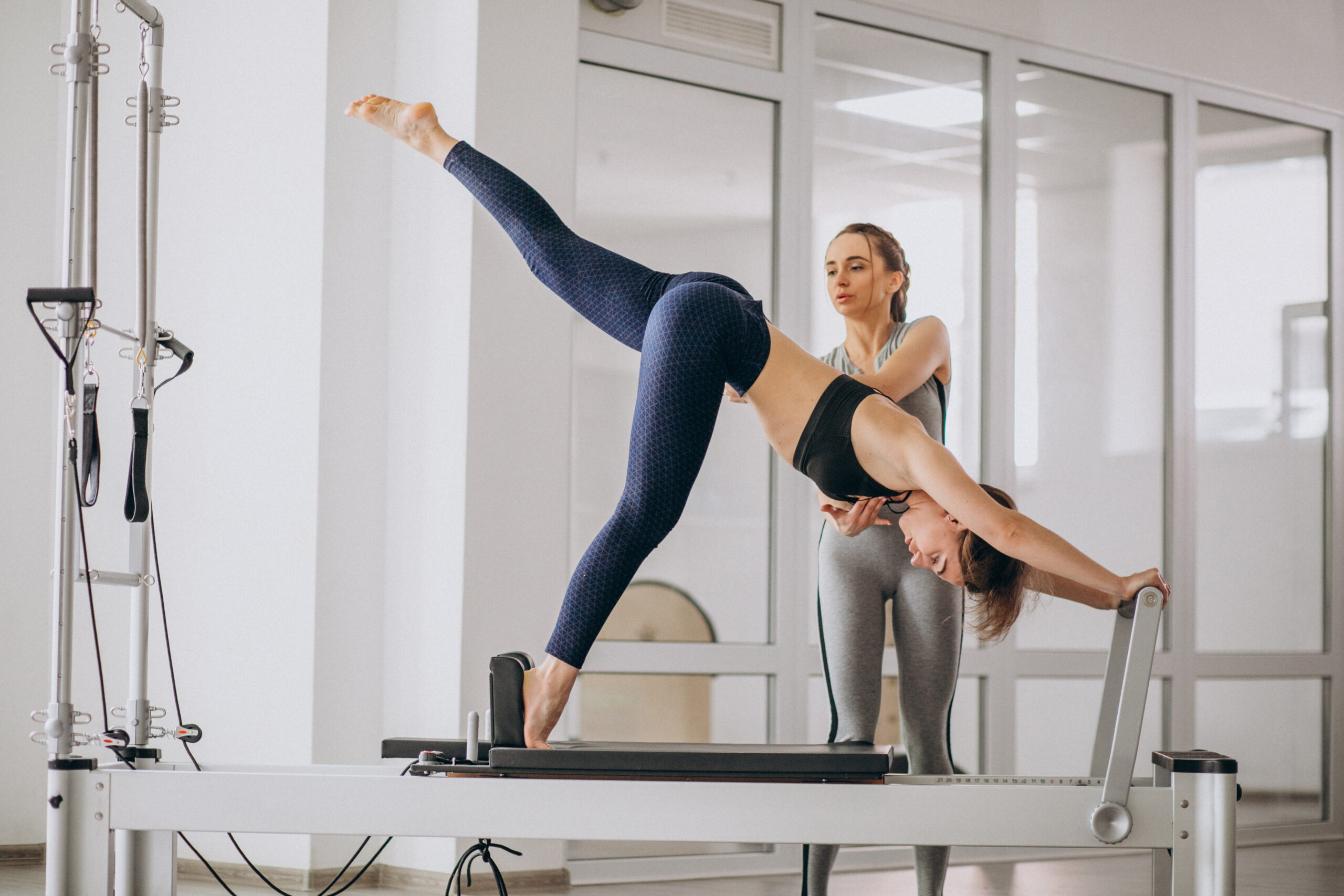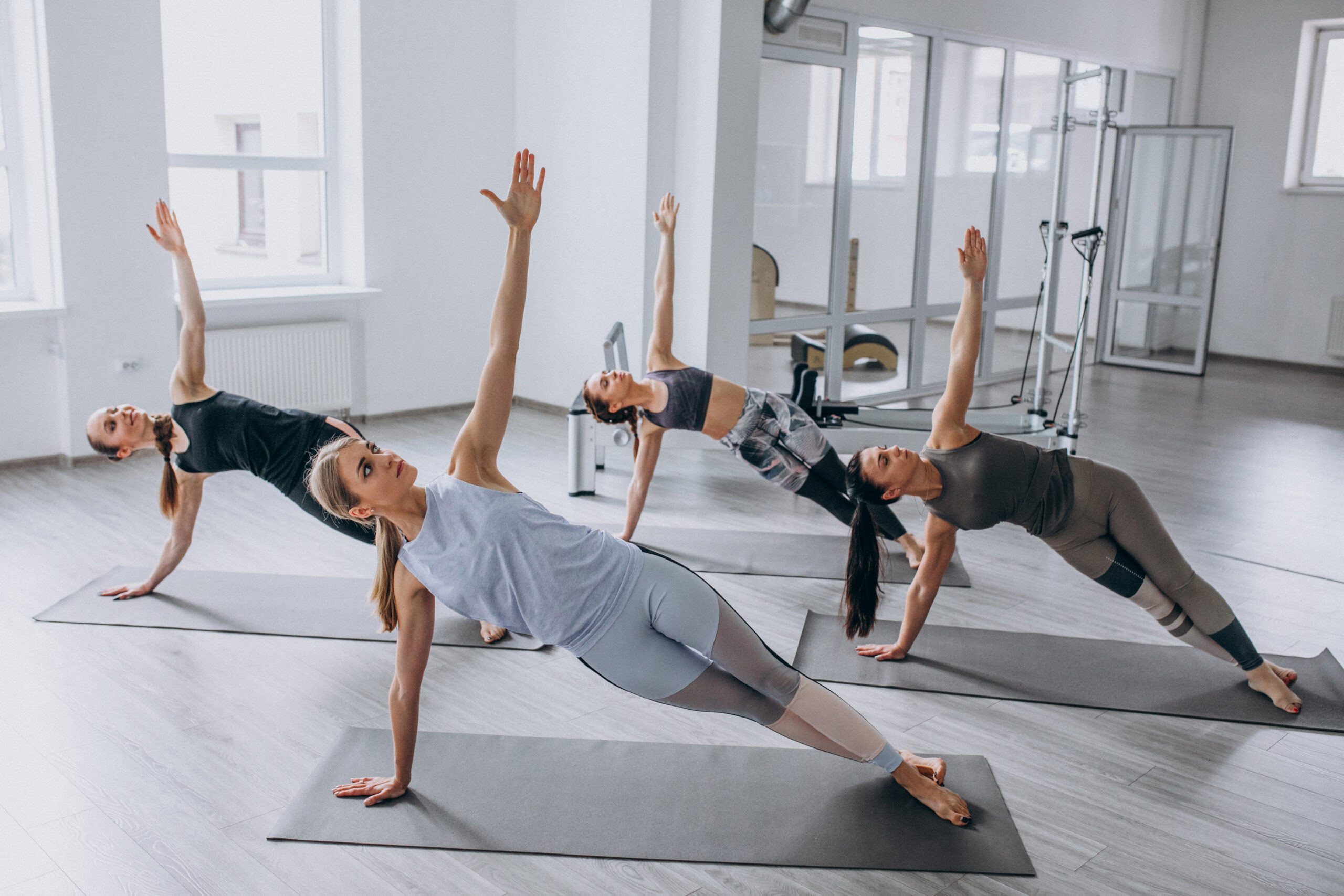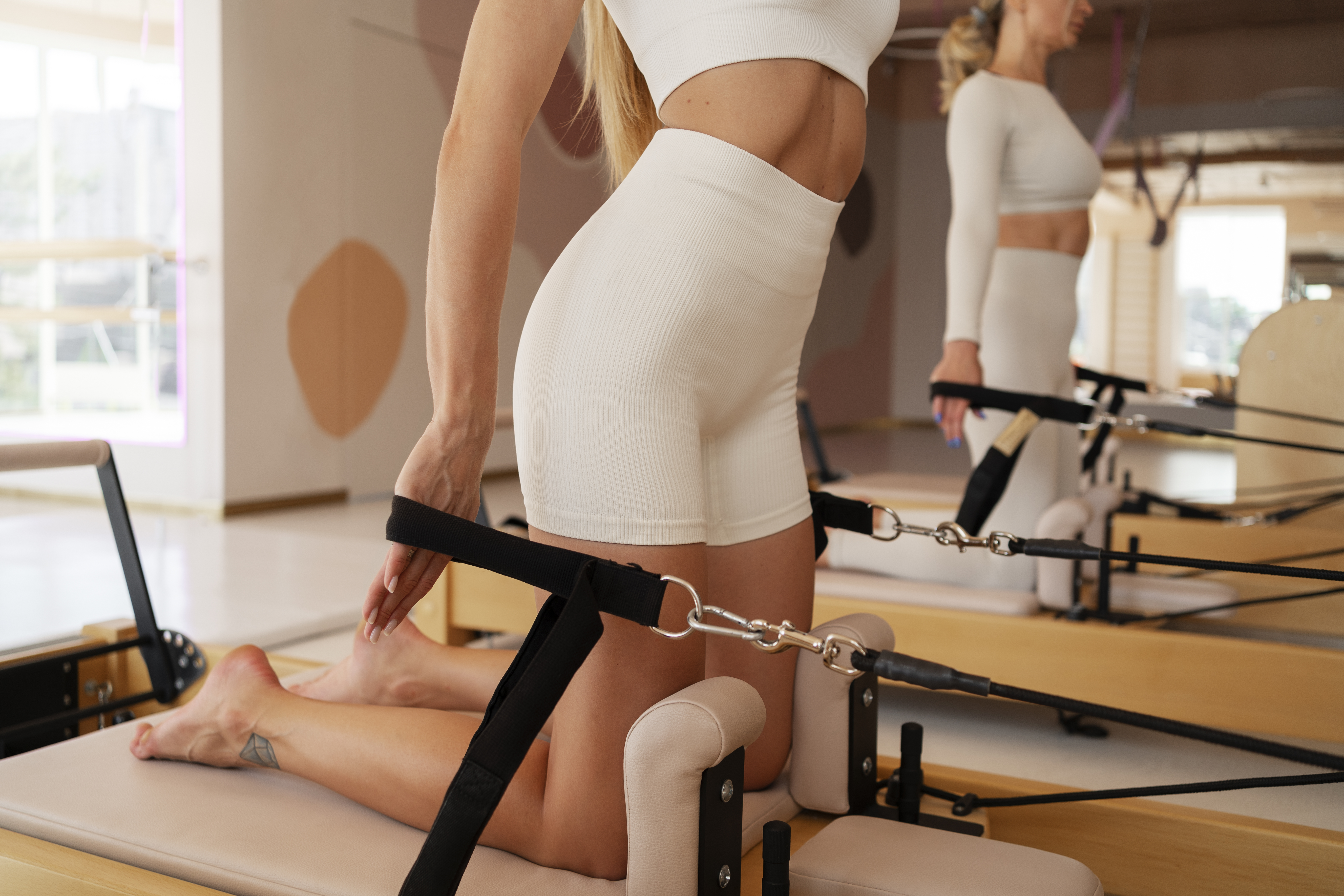Pilates is a method of moderate dynamics exercises that combines elements of yoga, isometric training, and ballet. Thanks to this, it positively influences muscle strength, endurance, and flexibility without causing excessive growth of muscle tissue. Specialists emphasize the beneficial effect of exercises on deep muscles (postural muscles).
Understanding the purpose of the exercise helps to master a precise technique and improves the mental involvement of the individual exercising in performing a targeted movement assignment. The primary goal is to balance muscle imbalance, generated in particular by weakening the activity of the deep muscles (stability muscles), and to restore the flexibility of the superficial muscles (mobility muscles).

Pilates![]() connects the mind and body, allowing the organism to move more efficiently. This training technique utilizes the body to its most splendid benefit, utilizing strength, flexibility, and coordination, and demands that the individual pay attention to the body throughout each activity. To achieve this powerful mind-body association, the subsequent six principles
connects the mind and body, allowing the organism to move more efficiently. This training technique utilizes the body to its most splendid benefit, utilizing strength, flexibility, and coordination, and demands that the individual pay attention to the body throughout each activity. To achieve this powerful mind-body association, the subsequent six principles![]() should be considered.
should be considered.
Controlling the breath is significant to comprehending Pilates and getting the greatest advantages from the training. Correct breathing is the foremost thing the individual should focus on throughout the motion. Concentrated, regulated breathing can help preserve accurate alignment and contract the muscles that need to be contracted and release those that do not need to be used. Breathing thoroughly and accurately will also support the flow of the activity and movements all the way through.
This principle concerns the necessary association between the mind and the body. Awareness of the individual is actions is essential for moving precisely and efficiently. Concentration permits the mind to manage and move the body efficiently and appropriately.
Each move in Pilates is controlled and should never be wasted. Keeping the action within an individual's abilities is essential for alignment and stability throughout the organism during the training.
Everything in Pilates is formed from the body center, called the powerhouse or core. To execute the exercises accurately, start from the center. Creating a powerful, stable, and elastic base is one of the most satisfactory consequences of practicing Pilates regularly.
Performing exercises and changes in body position in a careful and precise manner. Before starting each exercise, the body posture should be corrected in addition to activating the core muscles. This primarily concerns the correct position of the head, maintaining the physiological curvatures of the spine, and the axial positioning of the large joints in their neutral position. Attention should also be paid to the work of the muscles of the lower limbs, and flexibility should be maintained because their function significantly affects the correct positioning of the spine, especially in conditions where gravity impacts the vertical posture of a person.
It means performing exercises at a moderate pace, coordinated with the respiratory rhythm. Movements of the limbs and changes in body position should take place in a coordinated and fluid manner, without generating excessive tension in the muscles, leading to their acidification. As the fitness of the exercising person increases, more difficult variants of specific exercises should be implemented, and the possibility of including advanced exercises in the session depends on the individual predispositions and level of training of the exercising person.
The way a pre-workout warm-up should look depends on your general fitness level and the type of exercise you want to prepare for. A ten-minute warm-up is sufficient if you only have a training mat and are exercising at home. It is worth including stretching exercises![]() and jogging in a place that will raise your heart rate and body temperature.
and jogging in a place that will raise your heart rate and body temperature.
The more advanced the exercise, the longer and more complicated the warm-up should be. It is significant to perform all the exercises included in the warm-up carefully and when the muscles are relaxed.
After warming up, it's time to move on to Pilates exercises for a flat stomach![]() . Start in a neutral sitting position.
. Start in a neutral sitting position.
Grab your thighs under your knees, straighten your back, and with an exhale, lower your upper body until your arms are fully extended, rounding your back and tightening your stomach. Return to the beginning in the same path. Pull your navel towards your spine and your chin towards your sternum in each repetition.
After a few repetitions, return to the neutral position and extend your straight arms upwards. Slowly lower your body and place it on the floor.
Roll your spine back to a sitting position when initiating the movement with your belly. Keep your arms straight the whole time. While rolling, you can move them forward a little, which will make it easier for you to move.
For the next Pilates exercise at home, assume a lying position. Raise your straight legs vertically up (a right angle at the hips). Interlace your hands behind your head and do 15 abdominal crunches. After the last one, stop at the moment of tension and stay in this position for a few seconds.
Put your body back on the mat and move on to the next exercise. Your legs remain high, but now you should spread them apart in a V shape. Perform an abdominal crunch, leading your arms between your legs and doing two pulsating movements. This is one repetition. Try to do 10 of them.

Pilates spine exercises![]() are one of the greatest strengths of this training method. Thanks to them, you can get rid of pain and reduce the likelihood of a spine injury.
are one of the greatest strengths of this training method. Thanks to them, you can get rid of pain and reduce the likelihood of a spine injury.
Start by rolling your spine. Stand straight, hip-width apart. With an inhale, stretch your spine upwards with an exhale, and start lowering your torso towards the floor. Do this slowly by bringing your chin closer to your collarbone, rounding your shoulder blades, and bending your stomach. Hands facing down loosely. When you touch the floor, deepen the position and start rolling to the starting position. Straighten in the opposite order, i.e., first your hips, then your lower back and thoracic spine, and then straighten your head at the end. Perform a total of 4 such sequences.
Before starting the exercises, you should do a warm-up. You can march in place and perform torso twists or arm circles. Uncomplicated movements are enough to sculpt the leg muscles.
Lie on your back on an exercise mat. Place your hands along the line of your body. Raise your legs straightened at the knees above the floor and alternately point one down and the other up. The leg pointing down should not touch the ground. Your back must contact the entire mat surface throughout the exercise.
The starting point for this activity is lying on your back. Put a little ball between your feet and straighten them at the knees. Your back should be in touch with the ground, and place your arms parallel to your body. Raise your legs with the ball (squeeze it with your feet as hard as possible) to form a right angle with your torso. Make sure that it does not slide out from between your feet, tense the inner muscles of your legs for a few seconds, then return to the starting position.
The starting position is lying on your back on an exercise mat. Legs straightened at the knees, arms placed along the body. Raise the right leg to form a right angle with the body, then slowly make small circles to the right. After a few circles, change the direction of movement, and then move on to repeat the entire exercise scheme for the left leg.
To perform the exercise for the thighs, change your body position. Lie on your left side and support yourself on your forearm. Place the other hand on the exercise mat. The leg adjacent to the ground can be bent at the knee, while the other can be straightened. Repeat the sequence of movements several times: raise the limb farther from the ground and slowly lower it. Do not allow both legs to touch.
Pilates for beginners is a light form of training that you can do seven days a week. You probably shouldn't experience any strain because these exercises are supposed to eliminate such ailments, but always be careful and consult a health specialist before training.
If you’re starting your Pilates journey, it’s worth being patient and not pushing yourself. Specialists recommend starting with one or two sessions per week. Workouts can last 20 minutes and can be extended to an hour. Use beginner-friendly exercises designed by professional instructors. It will ensure that your Pilates workout at home is safe and effective.
You don’t need space to do Pilates at home – just enough to spread a Pilates or yoga mat on a flat surface. Once you’ve learned the basic techniques, you may buy smaller tools like a resistance band and exercise ball to enhance the training.
There are two categories of Pilates equipment: large equipment like a reformer, tower, or trapeze table available at Pilates studios and small equipment. The latter is used for mat exercises and includes dumbbells, resistance bands, exercise balls of various sizes, a roller, a rehabilitation ball, and a Pilates hoop.
You can take Pilates lessons on the mat in a studio or at home. A Pilates mat is different from a yoga mat.
Comfortable and fitted workout clothes are best. Tight clothing allows you to see the work of your joints and muscles while giving you freedom of movement. Avoid clothes with inflexible elements – you don't want metal digging into your body during exercise, causing pain or discomfort. For women, a front-fastening bra or sports top is much more comfortable than a traditional bra with an embroidered clasp at the back (you will feel it when you're lying on your back).

Pilates consists of exercises that enhance body flexibility and overall well-being. These simple exercises can also help activate and tone different body areas. People of all ages and fitness levels can benefit from Pilates.
Strengthening the entire body's muscles![]() enhances the strength of the muscles in almost the full body, especially the abdominal, back, and buttock muscles. It also strengthens the pelvic floor muscles, which support the vagina, bladder, and uterus. It helps prevent reproductive organ prolapse and improves sexual satisfaction. It also aids in muscle control during childbirth.
enhances the strength of the muscles in almost the full body, especially the abdominal, back, and buttock muscles. It also strengthens the pelvic floor muscles, which support the vagina, bladder, and uterus. It helps prevent reproductive organ prolapse and improves sexual satisfaction. It also aids in muscle control during childbirth.
Pilates to prevent spinal problems were primarily developed for individuals with spinal issues. It strengthens the muscles that stabilize and support the spine and other muscles that help maintain spinal alignment.
Improves body posture Pilates enhances spinal stability and helps correct the relationship between the hip bone and the spine. This results in a straighter and more stable posture.
Pilates is a workout that involves your body weight because many exercises require the involvement of large muscle groups to maintain balance. By activating the muscles, collagen production is increased, and blood circulation in the skin is improved. This makes the skin firmer and more elastic.
Pilates leads to calmness, reduces stress, and restores mental balance. Unlike other exercises, after the end of a Pilates session, the exerciser is rested and full of energy. This is because precisely performed exercise elements are designed to remove tension accumulating in the spine (especially in the lumbar region) and shoulder girdle. Pilates also relaxes the upper back, neck, and shoulders.
Pilates exercises increase your awareness of your body by connecting it with the mind and teach you to listen to its signals. Pilates helps the mind control the entire body, leading to complete harmony of the body.
Pilates exercises can be performed by almost anyone, including seniors and children if there are no contraindications. Although they are not very dynamic and not intense in terms of effort, concentration and precision are significant. Pilates is an amazing workout for beginners who want to eliminate the effects of a sedentary lifestyle.
Pilates is a form of exercise that works for almost everyone. The lack of age restrictions means that it can be practiced by seniors, overweight people, and people with poor physical condition. However, there are some exceptions. Some injuries, traumas, or chronic diseases may disqualify you from taking Pilates training. Before starting your Pilates adventure, consulting a doctor or physiotherapist is worth ensuring that such training will not harm you.
Women in the first trimester of pregnancy should give up Pilates because, during this period, there is the highest risk of miscarriage. In addition, this type of training is not recommended for people with unstable blood pressure and other problems related to blood pressure, as well as in the case of thrombosis, during acute inflammation, after recent bone fractures, spondylolisthesis, recent surgeries, osteoporosis, and disc herniation.
People with serious health problems should also avoid Pilates unless the doctor recommends otherwise.